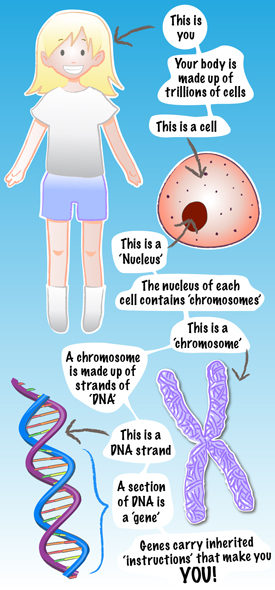GENETICS BASICS In THE UK
The many complex sounding words and phrases used in genetics can be quite baffling. This section will help it all begin to make sense.
We all began life as a single cell at conception when an egg from your mum and sperm from your dad came together. This single cell divided into two and then into four and so on until you developed into a complete human being made up of billions of cells. It was your genes that instructed your cells to divide in this way and that controlled how you developed.
The role your genes play in shaping who you are doesn’t end at birth.
Your genes are constantly being used by your body throughout your life to keep it functioning. They interact with the environment around you and influence everything from your health to your appearance, your behaviour and your personality.
Our fun, simple animation will show you What ‘Genes’ Means
Chromosomes, Genes and DNA
Inside almost every one of oure cells is a tiny structure called the nucleus which acts like the control centre of the cell. Inside the nucleus are 46 chromosomes. Each one is made up of a long strand of DNA. Along the length of the DNA strand are hundreds of genes (like beads on a piece of string – the string is the chromosome and the beads are the genes).
It is estimated that if a strand of DNA was stretched out, it would be around two meters long, even though the average cell is smaller than a pinhead.
Chromosomes
Our 46 chromosomes come in 23 pairs. The chromosome pairs are numbered from the longest, number 1, to the shortest, number 22. The 23rd pair of chromosomes are our sex chromosomes, the X and Y chromosomes. Women have two X chromosomes (XX) and men have one X and one Y chromosome (XY). All the other chromosomes are the same in males and females. We inherit one chromosome in each pair from our mum and the other from our dad. When cells divide the chromosomes pair up which is why they’re often shown as ‘x’-shaped in diagrams like the one on the right.

Genes
The strand of DNA which makes up each of your chromosomes is arranged into sections called genes. Each gene is a single instruction which tells the body how to do a particular job, for example, make this person have brown eyes or make this person have freckles.
Almost every cell in your body (with the exception of red blood, egg and sperm cells) contains a complete set of around 20,000 genes – known as your genome.
But the cell only uses the ones it needs to carry out its role. So a brain cell will use some different genes from a lung cell, for example, the Cystic Fibrosis gene is needed for the cells that line the lungs to function properly, but it is not needed for a brain cell to do it’s job. This is why the genetic condition Cystic Fibrosis affects the lungs and does not affect the brain.
We have two copies of almost every gene, inheriting one copy from our mum and the other from our dad. It is different for genes on the X and Y chromosomes and mitochondrial genes.
DNA
DNA (deoxyribonucleic acid) is a very long double-stranded molecule, tightly coiled into a ‘double helix’ shape which looks like a twisted ladder. The ‘rungs’ of the ladder are made up of pairs of interlocking units called bases or nucleotides. There are four different bases represented by the letters A (adenine), T (thymine), C (cytosine) and G (guanine). ‘A’ always pairs up with ‘T’, and ‘C’ with ‘G’.
In the DNA code these letters are read in groups of three spelling out three letter ‘words’, called codons. Strings of codons in a section of DNA form sentences and paragraphs, or ‘genes’. So a ‘gene’ is a sequence of bases (ATTCAGCGA etc.) which encodes the instructions for making proteins – the machinery for the body’s chemistry.
So if you think of the entirety of your genetic make-up being an encyclopaedia, then a chromosome is a chapter, a gene is a paragraph and the letters and words that make up each paragraph are the DNA code.
Useful Links
If you would like to learn more about genetics you might find some of the links below useful.
Your Genome – This website is intended to help people understand genetics and genomic science and the implications for us all.
National Genetics and Genomics Education Centre – This website has resources and self-directed education about genetics aimed at NHS staff.
http://www.geneticseducation.nhs.uk/
GeneEd – This website was developed by the National Library of Medicine in collaboration with the National Human Genome Research Institute,It explores topics such as cell biology, DNA, genes and chromosomes.
Unique Tales Booklet – A fun cartoon-style booklet aimed at children to help explain about chromosomes and chromosome conditions. Lots of adults enjoy it too! The booklet has been produced by the rare chromosome condition charity Unique.
http://www.rarechromo.co.uk/files/UniqueTales.pdf
KidsHealth – The basics on genes and genetic conditions for children and teens
http://kidshealth.org/teen/your_body/health_basics/genes_genetic_disorders.html





